Take a look at all our Webinars and Events!


Competitor Pricing Made Easy
Next Level of CPQ
Llm and pricing, elevate pricing with elasticity, optimise pricing with sensitivity, case study - 6 min read, how to write a pricing strategy for my business plan.
In this blog you will learn about the importance of choosing the right pricing strategy for a successful business plan.
BLOGS & ARTICLES
Get your ceo book for intelligent pricing.

- How to become a Hyperlearning organisation
- How to develop your organisational processes
- How to choose an algorithm that fits your business
Get your playbook for behavior-Based Pricing and using AI Driving Tooling
- Increase margin & revenue
- Become a Frontrunner in your market
- Be agile, use AI pricing software & learn from it to become a Hyperlearning Organisation
Why is a pricing strategy important for a business plan?
A business plan is a written document outlining a company’s core business practices – from products and services offered to marketing, financial planning and budget, but also pricing strategy. This business plan can be very lengthy, outlining every aspect of the business in detail. Or it can be very short and lean for start ups that want to be as agile as possible.
This plan can be used for external investors and relations or for internal purposes. A business plan can be useful for internal purposes because it can make sure that all the decision makers are on the same page about the most important aspects of the business.
A 1% price increase can lead to an 8% increase in profit margin.
A business plan could be very lengthy and detailed or short and lean, but in all instances, it should have a clear vision for how pricing is tackled. A pricing strategy ultimately greatly determines the profit margin of your product or service and how much revenue the company will make. Thorough research of consultancy agencies also show that pricing is very important. McKinsey even argues that a 1% prices increase can lead up to an 8% increase in profits. That is a real example of how small adjustments can have a huge impact!
It is clear that each business plan should have a section about pricing strategies. How detailed and complicated this pricing strategy should be depends for each individual business and challenges in the business environment. However, businesses should at least take some factors into account when thinking about their pricing strategy.
What factors to take into account?
The pricing strategy can best be explained in the marketing section of your business plan. In this section you should describe what price you will charge for your product or service to customers and your argumentation for why you ask this. However, businesses always balance the challenging scale of charging too much or too little. Ideally you want to find the middle, the optimal price point.
The following questions need to be answered for writing a well-structured pricing strategy in your business plan:
What is the cost of your product or service?
Most companies need to be profitable. They need to pay their expenses, their employees and return a reasonable profit. Unless you are a well-funded-winner-takes-all-growth-company such as Uber or Gorillas, you will need to earn more than you spend on your products. In order to be profitable you need to know how much your expenses are, to remain profitable overall.
How does your price compare to other alternatives in the market?
Most companies have competitors for their products or services, only few companies can act as a monopoly. Therefore, you need to know how your price compares to the other prices in the market. Are you one of the cheapest, the most expensive or somewhere in the middle?
Why is your price competitive?
When you know the prices of your competitors, you need to be able to explain why your price is better or different than that of your competitions. Do you offer more value for the same price? Do you offer less, but are you the cheapest? Or does your company offer something so unique that a premium pricing strategy sounds fair to your customer? You need to be able to stand out from the competition and price is an efficient differentiator.
What is the expected ROI (Return On Investment)?
When you set your price, you need to be able to explain how much you are expeciting to make. Will the price you offer attract enough customers to make your business operate profitable? Let’s say your expenses are 10.000 euros per month, what return will your price get you for your expected amount of sales?
Top pricing strategies for a business plan
Now you know why pricing is important for your business plan, “but what strategies are best for me?” you may ask. Well, let’s talk pricing strategies. There are plenty of pricing strategies and which ones are best for which business depends on various factors and the industry. However, here is a list of 9 pricing strategies that you can use for your business plan.
- Cost-plus pricing
- Competitive pricing
- Key-Value item pricing
- Dynamic pricing
- Premium pricing
- Hourly based pricing
- Customer-value based pricing
- Psychological pricing
- Geographical pricing
Most of the time, businesses do not use a single pricing strategy in their business but rather a combination of pricing strategies. Cost-plus pricing or competitor based pricing can be good starting points for pricing, but if you make these dynamic or take geographical regions into account, then your pricing becomes even more advanced!
Pricing strategies should not be left out of your business plan. Having a clear vision on how you are going to price your product(s) and service(s) helps you to achieve the best possible profit margins and revenue. If you are able to answer thoughtfully on the questions asked in this blog then you know that you have a rather clear vision on your pricing strategy.
If there are still some things unclear or vague, then it would be adviceable to learn more about all the possible pricing strategies . You can always look for inspiration to our business cases. Do you want to know more about pricing or about SYMSON? Do not hesitate to contact us!
Do you want a free demo to try how SYMSON can help your business with margin improvement or pricing management? Do you want to learn more? Schedule a call with a consultant and book a 20 minute brainstorm session!

HAVE A QUESTION?
Frequently asked questions, related blogs.

4 Tips for keeping your pricing manageable

How to implement a new pricing strategy in 4 steps

How To Price Your Products: 5 Most Common Strategies
Other case studies you might be interested in.
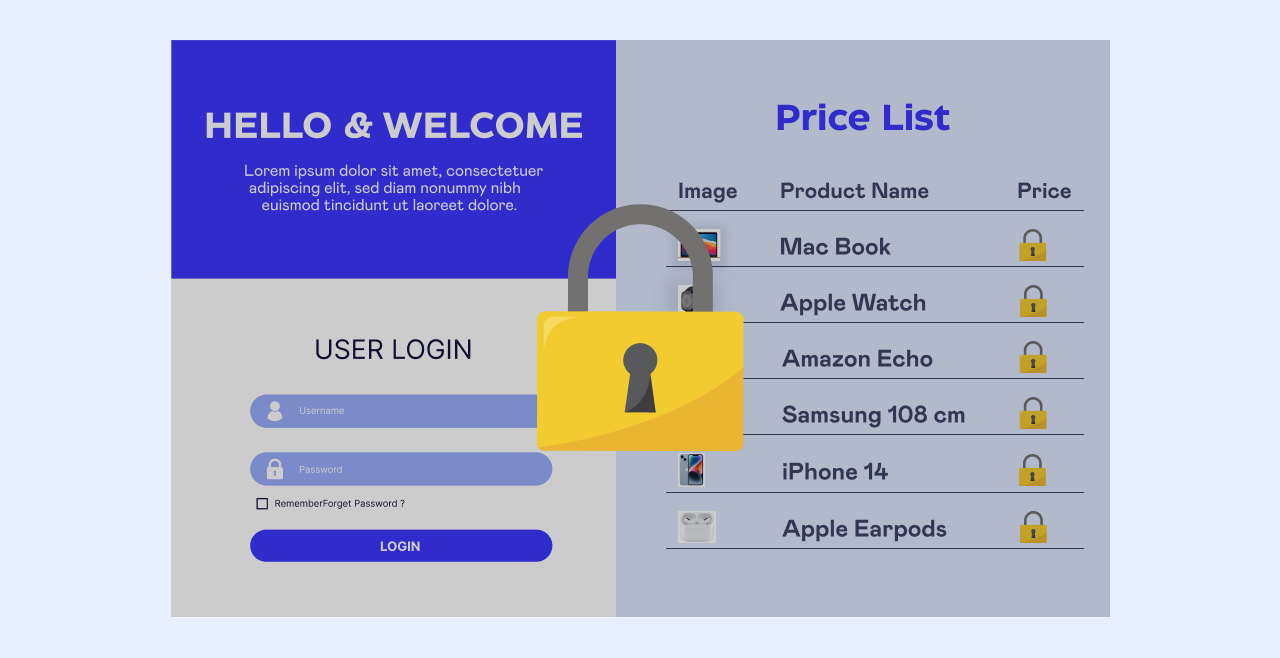
B2B Price Monitoring: How to Monitor Competitor Prices Beyond B2B Portals Logins

How LLM-Powered Tools Help You Optimise Your Business Processes

Hyperlearning

Ready to kickstart your pricing journey?
Talk to a SYMSON expert now
Empowering hyperlearning ™.
How to Write Pricing Strategy for Your Business Plan
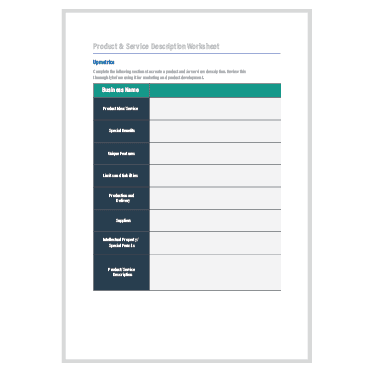
Product and Service Description Workbook
- May 16, 2024
- 15 Min Read
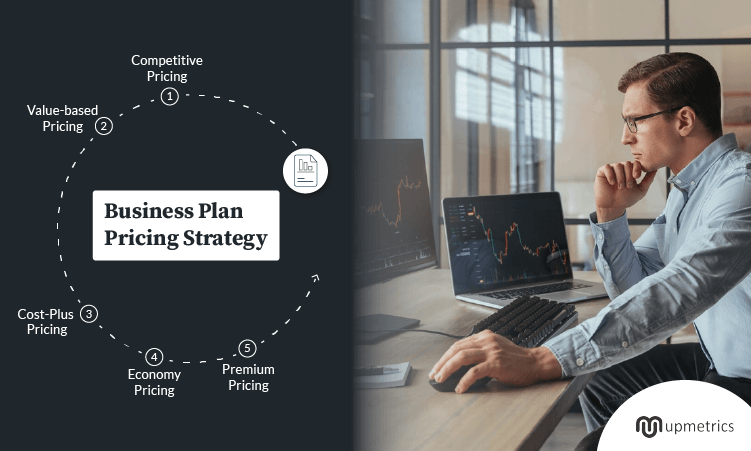
You have finally created that awesome product. It’s now time to sell.
At what cost?
This is the question that troubles most businesses.
Price your products too high and you see low sales. Price it too low and you struggle to make profits.
What’s the sweet spot to finding a balance between profitability and business sustenance?
The answer is a smart pricing strategy in your business plan . But how to decide on a pricing strategy for your products?
This article is your answer.
In this guide to creating the right pricing strategy, we cover everything you need to know about a pricing strategy from A to Z.
Let’s decode the recipe to a pricing strategy that brings in both: great profit margins and happy customers.
What is a pricing strategy?
A pricing strategy is a model you use to decide the price of your products or services.
It is a critical component of your business plan, as it decides on how you:
- Make profits
- Compete against competitors
- Optimize conversion and lead generation
Creating the right pricing strategy means taking into account various factors such as market conditions, competition, production costs, perceived value to the customer, and so much more.
We agree it’s the hard part.
The main objective: Establish a price point that’s good enough to attract customers while also maintaining profitability for effective financial planning.
Why is pricing strategy critical to a business plan
A recent survey by Bain and Company found that roughly 85% of businesses are seeking an improvement in their pricing decision-making process. On the other hand, McKinsey contends that even a mere 1% increase in prices can result in an impressive 8% boost in profits.
Your business plan is a document that contains the goals of your company and how you plan to achieve them. A pricing strategy highlights how you will be making actual profits from your product offerings to achieve those goals.
The price you set reflects not only the value you assign to your brand’s products and customers but also serves as a pivotal factor that can either attract or deter potential buyers.
Let’s delve deeper into the benefits of the right pricing strategy in a business plan:
Establishes the road to profitability: Your pricing strategy determines your profit margins. By understanding your costs and competitors’ pricing, you can set a price that ensures profitability and sustainability for your business.
Enables better market positioning: An optimized pricing strategy helps you put your products and services in the correct price bracket. It guides your business and helps you decide which market position to occupy for the best chances of success.
Helps project demand: With a good pricing strategy, you can project and satisfy the demand for your product or service. Choosing the optimal pricing strategy (such as skimming, penetration, or value-based pricing) will help you manage demand fluctuations and optimize sales volume. This makes your business plan stronger.
Helps project ROI: You also get a rough idea regarding your sales goals with a strong pricing strategy based on competitor and marketing analysis.
Enhances chances for funding: If you’re a startup seeking funding, a strong and thoroughly analyzed pricing can highly strengthen to secure funding.
With an understanding of the criticality behind integrating a pricing strategy into your business plan, it’s now time to explore some real-world pricing strategies before you come to designing your own.
Choosing the best pricing strategy for your business
“You know you’re priced right when your customers complain—but buy anyway.” — John Harrison
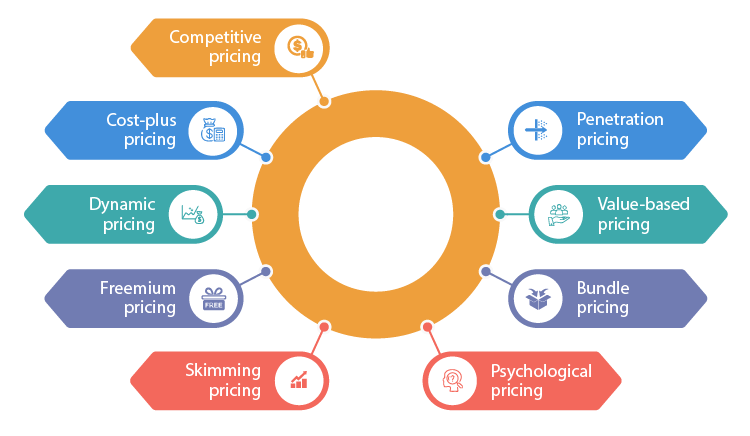
You know what it is, and you know why you need it. But which strategy should you implement? What’s the best one for you?
Let’s get you out of all these conundrums with our comprehensive list of best pricing plan strategy examples.
Competitive pricing
The competitive pricing strategy involves setting your prices based on what your competitors are charging for similar products and services.
As such, it’s ideal for businesses venturing into markets that sell similar products such as groceries or retail stores.
Think of how airline prices for a particular destination all rise up together during holidays.
A competitive pricing strategy is used both in B2B and B2C sectors like communication services, retail stores, grocery, telecom market, and more.
Essentially, you can implement this strategy by:
- Setting your prices below competitors’
- Setting your prices similar to your competitors’
- Setting your prices a little above your competitors
What approach you choose depends on how well you know your market or customer. For instance, if you price your goods a bit lower, you may attract more customers. However, you must make sure not to attract big losses.
If you decide to set your product prices higher than your competitors, you’ll want to draw on some ideas from value-based pricing strategies that help clarify why you are charging more for your products. Are you offering better quality? Are you treating customers better?
Marketing efforts like a refund scheme, better customer experience, and more will play a crucial role in justifying the higher cost to customers.
Value-based pricing
The value-based pricing method works based on what your customers think the value of your product should be.
Thus, the price is dependent on what the customer is willing to pay (WTP price) for your product.
Depending on the value that you bring to your customers’ business or life, you get a chance to price your products much higher than the actual production cost.
Think of how a fine-dining restaurant sets its price. While it may seem exorbitant to some, patrons willing to throw in that amount happily visit such a place.
This technique is well used by B2C or B2B service providers, freelancers, and experts who teach a specific skill.
Apple, in particular, is notorious for using this strategy to demand excessive prices for products that are either only slightly better or equivalent to their counterparts.
Cost-plus pricing
The cost-plus pricing strategy pulls us away from a “willing to pay” towards a more business-centric approach. This strategy, aptly named markup pricing, involves taking into account the production cost and simply adding an extra dollar value to it.
Cost-plus pricing, in a nutshell:
My production costs + Markup price = My selling price.
If you plan to sell a product that costs you $100 to produce. Simply speaking, you now need to sell the product at a higher price to earn a profit.
If you want a 20% profit margin, you have to sell at $120. If you want a 15% profit margin, you sell at $115. Pretty easy, right?
With the cost-plus strategy, it becomes easy for you to get a rough draft regarding the profits you can generate depending on the volume of your sales.
So, let’s say you have a profit goal of $10000 and a profit margin of 20% with each product costing $100 to make.
Thus, your sales goal should be
$10000/$20 = 500
You need to sell 500 units to reach that goal.
Economy pricing
In the economy pricing strategy, you sell products at a bargain price, i.e. at the lowest price to get your potential customers to start buying your products.
While this method might seem quite similar to competitive pricing, there is a hidden catch.
Unlike competitive pricing, economy pricing targets those customers who may be okay with a slightly lower product quality or those who don’t care about brand image.
By sourcing cheaper supplies and streamlining features, you can offer extremely low prices for your goods while remaining profitable.
You might have noticed a retail chain’s cheaper alternative sugar packet stocked right beside the branded ones. Another great example includes generic drugs—they are priced lower because they come with lower production costs.

Premium pricing
The premium strategy is exactly the opposite of the economy pricing strategy. Instead of selling products at their cheapest, you hike up the price to give customers the essence of a luxury product.
Of course, companies do add some additional value to their products but the bulk of the pricing comes from the perception of the product as high-end by the customer.
Psychological pricing
The psychological pricing strategy plays with the psyche of your customers to make them want to buy your stuff.
For instance, one of the most popular and widely used techniques in this strategy is the 9-digit effect. It suggests that even though a product priced at $9.99 is essentially $10, customers perceive it as a better deal due to the presence of the “9” in the price.
Placing the target product next to an expensive alternative, giving good deals, tweaking your typography, and inducing FOMO (fear of missing out) are some other basic ways to subtly manipulate buyer psychology.
Dynamic pricing
Dynamic pricing goes by many names—surge pricing, demand pricing, or time-based pricing. And as the names suggest, it is a pricing strategy that is flexible in nature and is catered to adjust to the fluctuating market and customer demands.
Dynamic pricing lives and dies with your monitoring and analysis capabilities. You need to stay on top of various metrics like supply and demand, spatio-temporality, customer preferences, and more.
Penetration pricing
In this strategy, you enter the market with a low baseline price for your products. That attracts customers and you set up your market presence. This helps you pull customers away from competitors who demand higher prices for similar products. That’s what the penetration strategy is all about.
Do note that this strategy may not be always sustainable in the long run. This requires you to have a suitable plan in place once you establish a suitable foothold in the market.
Uber made great use of this strategy. They started with a customer-centric strategy where rides were cheaper than the competing taxi service.
Price skimming strategy
As a complete opposite to the penetration strategy, we have price skimming, where you start off with a high price and slowly bring it down.
Price skimming works best when you are stepping into a market where there’s not a lot of competition, focusing on a specific bunch of customers, and really highlighting the value of your product or service.
Of course, this comes with a hefty upfront investment in marketing and promotional campaigns.
Once more players start popping up in your market, you’ve got a chance to drop your prices a bit and snag a larger slice of the customer pie.
Take the Apple iPhone, for instance. They frequently employ a price-skimming strategy when they first release a new model. But once competitors like the Samsung Galaxy hit the market or they release newer models, Apple adjusts the price downward to maintain a competitive edge
Steps to design an ideal business pricing strategy
We covered a whole lot of potential pricing strategies that can make way into your business plan. However, you still need to decide which one is the most suitable for your business and how you can implement it. Let’s help you with that with some easy-to-follow steps:
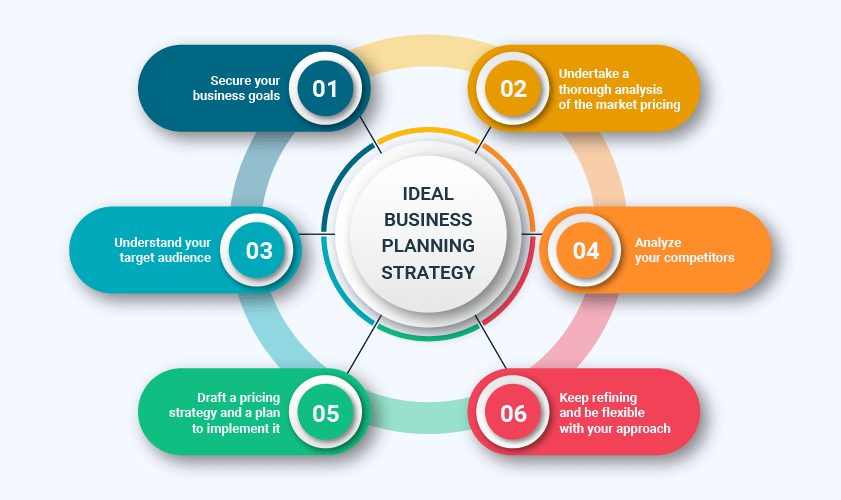
Step 1: Secure your business goals
The first and most important step is to understand what your business needs. You need to discern what your pricing should depend on.
Is it increasing profitability, improving cash flow, extending your market share, beating a competitor, reaching out to a new audience, or introducing a new product?
Your entire pricing strategy will depend on these factors. Choose wisely.
Step 2: Undertake a thorough analysis of the market pricing
Ensure that your pricing strategy is suitable for both internal affairs and market conditions.
For instance, if the market you choose is saturated, you must gear up for competition and go for something on the lines of a competitive pricing approach. On the flip side, if it’s a new market, you can go for a value-based pricing approach.
Step 3: Understand your target audience
Why should your customers purchase your products? What will they buy and how should you provide it to them? Is it a premium customer base? Or are you targeting price-sensitive customers?
These are essential questions you need to find the answer to. It is only by knowing your target audience and your Ideal Customer persona that you can initiate and maintain your sales.
Opening a fine-dine restaurant in a Tier-2 city? Value-based or premium pricing can work. Opening another cafe in a metro city? You’re in for competitive or economy pricing.
Step 4: Analyze your competitors
Identify at least three direct competitors and analyze how they structure their pricing. Take a look at whether they break down their pricing into components and offer significant discounts. This gives you a solid idea of how to price your own products.
Check if they bundle products or solutions with others. Look into value-based pricing, where clients pay a percentage of the perceived return on investment. When considering substitutes, think about what options customers might use and their costs.
Remember, sometimes the best solution is the decision to do nothing. Consider self-solutions or choosing not to address the issue, along with alternatives from indirect vendors.
Step 5: Draft a pricing strategy and a plan to implement it
Now that you have gathered enough info to design and draft your pricing strategy, this is the stage where you finalize everything and move on to the implementation stage. Depending on the above metrics, you can choose one of the aforementioned strategies.
We have already discussed the different pricing strategies. Pick one after you have thoroughly analyzed your market, competitors, production costs, and overarching business goals.
Here’s a quick cheat sheet for choosing and implementing the right strategy for you:
- Value pricing: Understand the value for your customers and their willingness to pay. Also, understand what alternatives they have.
- Competitive pricing: Set the price equal to what your competitors are charging and win the service game.
- Psychological pricing: Price products or services in a way that triggers action. For example, charging .99 instead of $1.00.
- Promotional pricing: Discounts over a period of time or one-time deals.
- Price skimming: Enter the market with a high price, but once your competitors follow, lower your cost and implement other pricing strategies.
- Economy pricing: Everyday low price with a focus on low manufacturing/delivery costs.
- Penetration pricing: Set a price artificially low to break into the market.
Step 6: Keep refining and be flexible with your approach
Don’t stress over finding the absolute perfect price. Instead, come up with a few options and give them a test run with your customers. You might be surprised to find that you can actually sell at a higher price than you thought with the right strategy.
But you won’t know until you try it out with potential customers. If the price doesn’t seem to work, take a look at any feedback you receive, tweak your pricing, and give it another shot
Tips to keep in mind:
- Try to Communicate with and understand your target customers. Know how much they can pay, what they are interested in, and how you can give them the best value. A good way is to use feedback forms.
- Always be flexible. If your pricing strategy doesn’t work, it’s time to research, experiment with different prices and adapt.
Bain and Company’s original research on pricing strategies also suggests useful tips. Make sure your sales staff is a part of your pricing and marketing strategy. If your pricing strategy is truly flexible that must also translate to better incentives for your sales team so they can sell more and sell better.
Get Started With Your Own Business Plan With Upmetrics
We just covered everything about pricing strategies. They are so critical to business planning as they help formulate your business goals, organize inventory plans, and increase your chances of achieving business goals.
However, there is so much more to a business plan than just pricing. If you want help creating a business plan from scratch, consider Upmetrics. It offers a collection of 400+ sample business plans for ideas and inspiration. Furthermore, AI assistance and automated financials make the process even easier for new users.
Interested? Try Upmetrics today!
Build your Business Plan Faster
with step-by-step Guidance & AI Assistance.
Frequently Asked Questions
A pricing strategy is a method used to determine the price of products or services, taking into account factors like market conditions, competition, production costs, and perceived value to customers.
How does a pricing strategy benefit you?
A pricing strategy helps in making profits, competing against competitors, optimizing conversion, and lead generation. It also draws in more customers, balances pricing, determines profitability, and assists in meeting customer expectations.
How should you choose the best strategy for your company?
To choose the best pricing strategy for your company, you should secure your business goals, analyze market pricing, understand your target audience, analyze competitors, draft a pricing strategy, and plan to implement it based on factors like value, competition, product positioning, and customer behavior.
About the Author
Upmetrics Team
Upmetrics is the #1 business planning software that helps entrepreneurs and business owners create investment-ready business plans using AI. We regularly share business planning insights on our blog. Check out the Upmetrics blog for such interesting reads. Read more
Get started with Upmetrics Al
- 400+ sample business plans
- Al-powered financial planning
- Collaborative workspace
Reach Your Goals with Accurate Planning

- Business Planning
How to Write Pricing Strategy for Your Business Plan

Written by Vinay Kevadiya
Published Sep. 4 2024 · 13 Min Read
Pricing products and services is a sensitive matter. You must strike the right chord to drive consumer demand and remain profitable.
To achieve this feat, you need a flawless pricing strategy for your business plan.
However, you may find it hard to price your offerings as a business owner—and you’re not alone. In fact, according to a survey, 85% of the companies believe there’s always room for improvement in pricing decisions.
But, no need to worry. This guide helps you create a solid pricing strategy so you can cater to your target audience while making enough to run a successful business. We’ll also discuss different pricing strategies and models.
Let’s begin.
What is a pricing strategy in a Business Plan?
Pricing strategy is the procedure to determine the price of products and services. These include variables like business goals, value proposition, demand and supply, financials, competition, market trends, and buyer personas.
Considering all these factors may sound confusing but creating an efficient pricing strategy is possible if you follow a stepwise procedure to arrive at a price point.
Importance of pricing strategy in a business plan
People often believe pricing strategy is mostly about selling a product or a service at the right price. Well, it’s more than that.
Here are some of its noteworthy benefits:
Clarity about financials
You get a clear view of all financial aspects including income, expenditure, and profit. This helps you to price your products or services reasonably.
Effective brand positioning
A buyer associates the price of a product with the perceived value, whether it’s related to utility or status. Hence, pricing strategy has a direct impact on brand value, credibility, and customer loyalty.
Gain in market share
The perfect pricing strategy for your business can prove to be a game changer, especially if you want to grab a large portion of the target market to maximize revenue and profits.
Edge over your competitors
According to an Accenture and GE study , gaining a competitive advantage is one of the top three priorities of 57% of enterprises. The right pricing strategy can help you achieve it.
Insights of market conditions
While creating a business plan , especially pricing strategy, you must consider external factors before arriving at a conclusion. As a result, you’re aware of all upcoming changes in the market and industry.
Pricing strategy vs. pricing model
Pricing strategy and pricing model—these two terms are often used interchangeably, leading to utter confusion.
While pricing strategy is an approach to setting the product prices, the pricing model is the way you implement the pricing strategy.
For example, the freemium pricing model is based on the penetration pricing strategy. You offer a free trial, limited access at a low price, or a forever-free version to attract prospects and then try to enroll them in a paid plan.
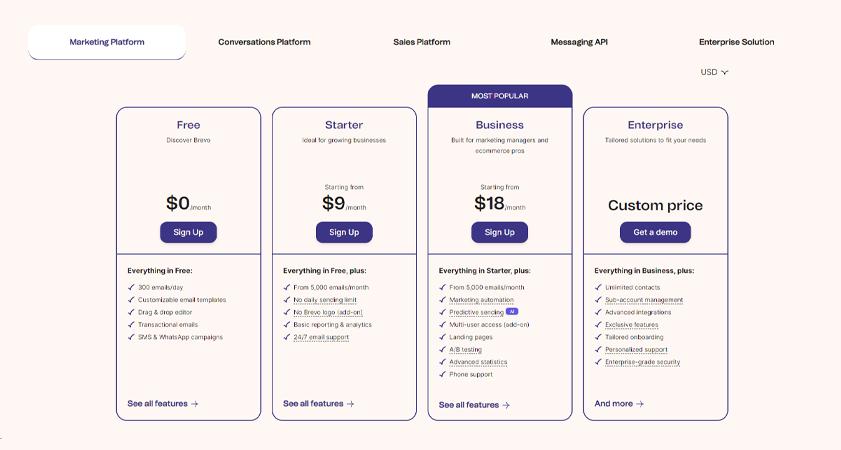
Source: Brevo
Let’s take another example of the hourly pricing model. It’s based on the value-based pricing strategy where you get paid for your services. The more experience you have, the more you get paid.
Similarly, we’ve other pricing models, also called pricing methods, that businesses use to generate revenue. The most important ones are:
- Bundle pricing
- Subscription pricing
- Project-based pricing
- Tiered pricing
- Flat pricing
- Promotional pricing
Pick the model best suited for your goals and the one delivering maximum perceived value to the customer.
10 Types of pricing strategies with real-life examples
Now that we know the importance of the pricing strategy in a business plan, let's explore various strategies deployed time and again to entice customers, destroy competition, and maximize profits.
We’ll also showcase real-world examples of companies utilizing a particular strategy to sell their products or services.
1) Value-based pricing
As the name suggests, value-based pricing is a pricing process based on the customer’s perceived value of a product or a service. The higher the value, the higher the product price. Therefore, we can say value-based pricing, also called value-added pricing, adopts a customer-centric approach.
The selling price is irrespective of the production and operating costs. Think of fine dining restaurants, luxury cars, art galleries, and haute couture. A business knows the product is unique, enhances the client’s self-esteem, and provides an unparalleled experience.
Real-world example: Starbucks, in comparison to other coffee beverage brands, is the most expensive . It charges a premium for its upscale image, relaxed and comfortable interiors, and sit-as-long-as-you-want policy.
2) Economy pricing
In economy pricing, you sell the products or services at low prices due to low production costs and negligible advertising costs.
Since the profit margin is thin, it can be successful only if you sell offerings in plenty (sales volume-based strategy). Examples comprise generic groceries, medicines, and budget airlines available at the lowest price to potential customers.
Real-world example: Amazon deploys economy pricing to sell multiple products at discounted prices under a generic brand called AmazonBasics.

Source: Amazon
3) Competitive pricing
Do you know for 87% of consumers , “getting a good deal” is important when choosing between brands or retailers? Buyers will always compare before spending.
This indicates the power of competitive pricing, also known as market-oriented and competitor-based pricing, a marketing strategy where a business prices its products or services based on competitors’ prices.
Real-world examples: Uber and Lyft, Amazon and Walmart, McDonald’s and Burger King, and so on.
4) Premium pricing
When you charge a higher price for a product or service than competitors to provide better quality and value, it’s called premium pricing. Businesses that opt for premium pricing often have few or no competitors. Luxury brands, for example.
However, premium pricing, also called prestige pricing, can backfire if a business’s equity doesn’t support its perceived value. In short, brands should be able to justify the premium price.
Real-world example: Rolex, the Swiss watch manufacturer. Their watches are of top-notch quality, robust, and as precise as possible. Hence, they demand a higher price for their products.
5) Cost-plus pricing
Also known as markup pricing, this strategy is one of the simplest pricing mechanisms. Simply add the desired profit, or markup, to the production cost to arrive at the selling price.
Formula: (Production cost) × (1 + Desired profit in %) = Selling price
Cost-plus pricing is ideal for products and services that are inelastic or less elastic, i.e., their demand remains unchanged in case of a price change. Gasoline, for example.
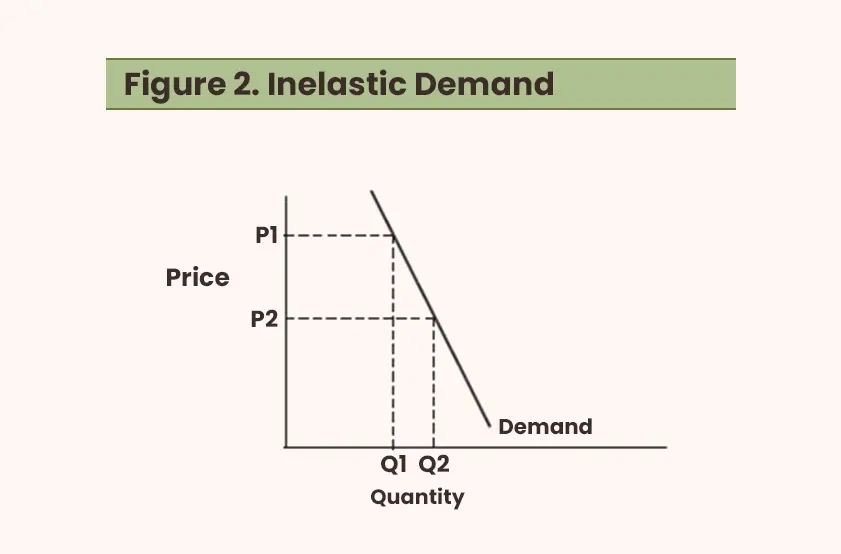
Source: Iowa State University
Real-world example: Everlane is one company that believes in transparent pricing. The retail store shares overhead costs and operating costs, allowing you to easily calculate the markup.
6) Penetration pricing
If you’re planning to launch a new product or service, a penetration pricing strategy should be your go-to to take the market by storm. This happens when you launch a product or service at a low price.
The penetration pricing should be used for a limited time as it restricts profit margins due to low selling prices. However, if the strategy delivers excellent economies of scale , you can keep the price unchanged.
Real-world example: Hulu, a streaming service, offers bundle packages at discounted prices. With its fierce pricing and unparalleled value, Hulu has been growing consistently .
7) Dynamic pricing
The practice of varying the price of products and services based on current market conditions such as demand, supply, seasonality, and time is called dynamic pricing.
Also referred to as time-based pricing, surge pricing, variable pricing, and demand pricing—dynamic pricing strategy works best to maximize revenue because it offers multiple price points for customers at different times.
Real-world example: Airbnb is a classic example of dynamic pricing. The prices go up when the demand goes up. Like when the holiday season is around the corner, or the prospect wants an immediate booking.
8) Skim pricing
Also called price skimming and high-low pricing, skim pricing is a marketing strategy wherein you launch a product or service at a high price, and then decrease it over time.
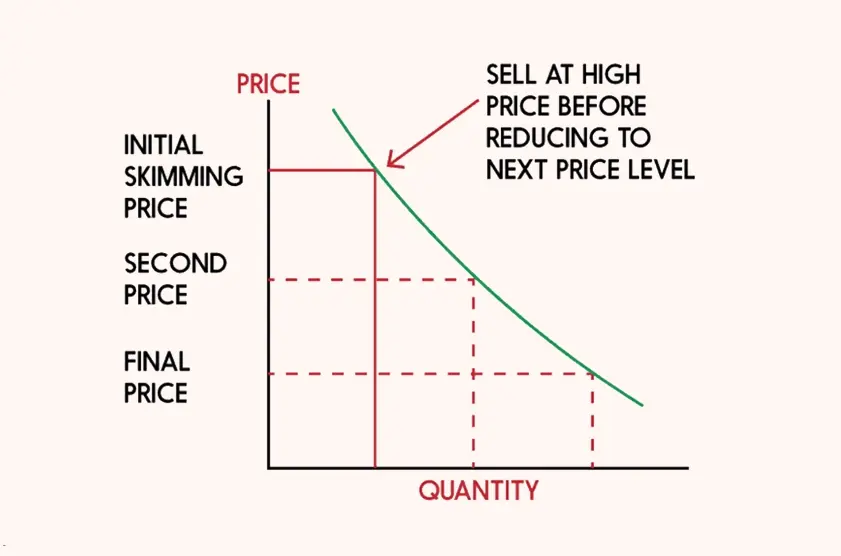
Source: FEEDOUGH
Price skimming is a short-term pricing strategy, targeting early adopters who are usually loyal customers and ready to pay a high price. The price decrease works best during sales to clear inventory.
Real-world example: Apple adopts the price skimming strategy. The newly launched iPhones attract early adopters. The older iPhone models are sold at lower prices, attracting price-sensitive customers.
9) Psychological pricing
Psychological pricing plays with human psychology to increase sales volume by altering buyer perceptions and decisions. For example, businesses place price tags ending with $9.99 or $9.95 instead of $10 to create a perception of lower prices.
The psychological pricing has many variants—charm pricing, prestige pricing, anchor pricing, decoy pricing, center stage pricing, buy-one-get one (BOGO), and so on.
Real-world example: Louis Vuitton, the French luxury fashion brand, deploys whole number pricing to render an expensive touch to their line of products. Their prices mostly end at 0.00.

Source: Louis Vuitton
10) Geographical pricing
Geographical or geographic pricing strategy revolves around adjusting the price of a product or service based on the buyer’s location and other geographic factors like regional culture, regulatory norms, income levels, and buyer behavior.
While local businesses can easily nail the pricing, a global enterprise needs to research properly before arriving at a price point. For example, differences in shipping costs have a major impact on product sales.
Real-world example: Adobe, a US-based software company. In India, the Adobe Creative Cloud Apps is available at a discounted price. Whereas in the US, it’s a little more expensive.
How to make an effective pricing strategy for your business plan?
Hope you got a complete understanding of how different pricing strategies work. It’s important because you will use one or more of these to come up with a strategy of your own.
Here’s the stepwise procedure to create a pricing strategy for your business :
1) Know your business goals
The ultimate aim of a pricing strategy is to mint money; every business wants increased revenue and profits. However, you can’t just focus on money. You need to have a goal that fuels your business.
Perhaps you want the largest market share, to attain new levels of brand equity, or to achieve the highest sales target ever. Whatever your goal, pricing is the pathway to achieve it. Therefore, before you begin to write the pricing strategy, note the goals.
2) Identify target audience
While pricing your products, you must know who your customers are and how much they’re willing to pay.
Create buyer personas to overcome the first obstacle of knowing your customers. Here’s everything you’ll learn about your target customer base:
- Demographic information like age, gender, location, language, education, relationship, preferences, etc.
- Psychological information like values, interests, challenges, pain points, fear, motivations, etc.
The answer to your second question lies in conducting a customer survey to gather data about prices. For this, check out the Van Westendorp Pricing Model . It’s a set of four survey questions that help you determine a range of acceptable prices for your product or service.

Source: Forbes
3) Study your competitors
Know what your competitors are charging from your target audience before you make a pricing move. Otherwise, it can be fatal for your business as the competitor will erode your market share.
Based on the information you have, proceed with a suitable pricing strategy.
For example, adopt a competitive pricing strategy if you’re providing the same value as your competitors. Choose value-based pricing when you know no one can match your value proposition.
If it's about more than just the price, you need to dig deeper. Competitor SWOT analysis and Porter’s Five Forces are excellent models to gauge your competition and other forces before finalizing a pricing strategy.
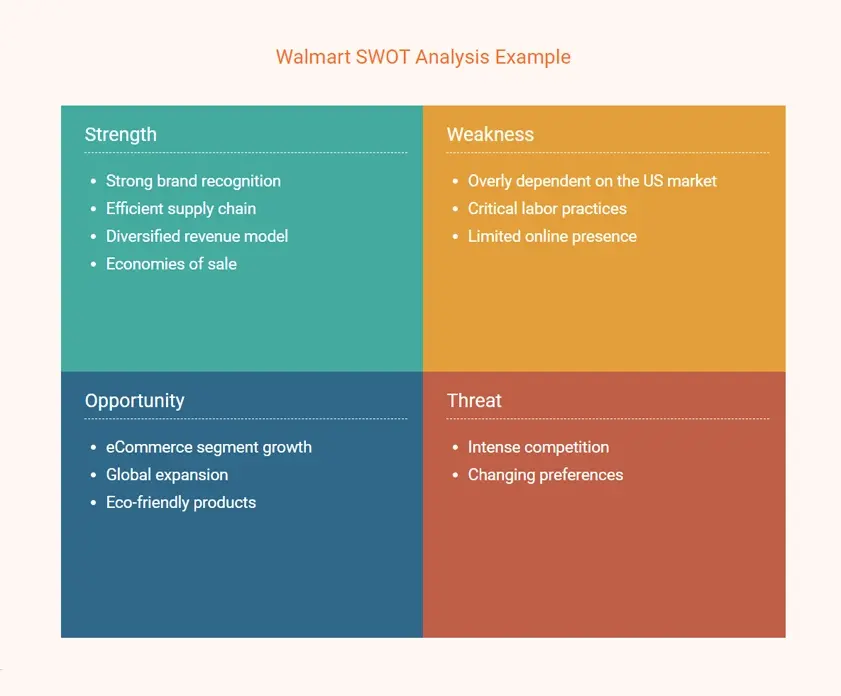
(Source: 7 SWOT analysis examples )
4) Calculate the costs
You can’t arrive at a price point unless you know the expenses associated with your business. Most pricing strategies are completely dependent on business costs, such as cost-plus price and penetration pricing.
Ensure you have access to complete data related to costs of goods sold (COGS), operating expenses (fixed costs and variable costs), and non-operating expenses. Once you have the information, you can add a markup or profit margin to set a selling price.
The value you provide to the end user at the expense of higher costs has a major impact on the pricing.
If you offer unique features, better quality, and outstanding customer support, opt for a premium pricing strategy. Conversely, economy pricing is apt for generic quality products manufactured at a lower price.
5) Write a pricing strategy for your business
Based on the criteria laid out above, you can start drafting a pricing strategy for your business plan. A few questions to ask while doing the job:
- Is the pricing aligned with your revenue goals?
- Are you providing enough value for the price you ask?
- Do you have a competitive advantage?
- Are all costs and expenses taken into consideration?
- Does the strategy help you with brand positioning?
If you get clear answers to these questions, your pricing strategy is in tandem with your business goals.
If you’re stuck somewhere, you can always seek expert help or use a credible AI business plan generator to ease your pain.
Conduct pricing analysis of existing products or services periodically based on sales performance and external factors. It helps you stay aligned with your goals. If anything seems off track, there’s always room for restructuring.
Now you have all the knowledge required to create a foolproof pricing strategy for your business plan.
Using this guide as a reference, come up with a blueprint to conquer the market, generate a continuous revenue stream, and establish a loyal customer base.
At any point, if you require an extra push to sail through the process, allow the AI business plan generator like Bizplanr to draft a robust business plan in a few minutes!
Get Your Business Plan Ready In Minutes
Answer a few questions, and AI will generate a detailed business plan.
Generate your Plan

Frequently Asked Questions
Is pricing strategy a business strategy?
Yes, it is. A pricing strategy is often referred to as a business or marketing strategy because it’s more about maximizing profit, gaining market share, and positioning your brand than just sales and revenue.
What is the pricing structure in a business plan?
The pricing structure in a business plan outlines how you will price your product or service. It includes details like the selling price, discounts, payment terms, and how your pricing compares to competitors. It’s a way to attract paying customers and stay competitive.
Freemium pricing, bundle pricing, and subscription pricing are some of the most used pricing structures.
How do companies formulate a pricing strategy?
Companies create a pricing strategy by researching their market, understanding their costs, conducting competitor analysis, and figuring out what customers are willing to pay.
They also consider their business goals, whether it’s to increase profit, grow market share, or establish a premium brand. Lastly, they choose a pricing model that aligns with these goals.

As the founder and CEO of Upmetrics, Vinay Kevadiya has over 12 years of experience in business planning. He provides valuable insights to help entrepreneurs build and manage successful business plans.
Follow Vinay Kevadiya
Related Posts

How to Write a Company Overview for a Business Plan

How to Write an Executive Summary for a Business Plan

How to Use AI to Write a Business Plan: A Detailed Guide
🎧 Real entrepreneurs. Real stories.
Subscribe to The Hurdle podcast today!
Pricing Strategies and Models Explained
4 min. read
Updated January 18, 2024

What’s the right price for your product or service?
What price will make you profitable and attract customers?
Not sure? Keep reading to learn the basics of pricing strategy and setting the right price.
- What is a pricing strategy?
A pricing strategy is the overarching approach or plan a business uses to determine the price of its products or services.
It considers various factors such as market conditions, competition, production costs, and the perceived value to the customer. The ultimate goal of a pricing strategy is to maximize profitability, maintain or grow market share, and ensure long-term sustainability while meeting the company’s other objectives.
- What is a pricing model?
A pricing model is the specific method used to set the price of a product or service. It provides a structure to implement your chosen pricing strategy.
What’s the difference?
The distinction between a pricing strategy and a pricing model lies in their scope, purpose, and application.
The pricing strategy aligns prices with business objectives, market conditions, and customer perceptions. A pricing strategy considers market entry tactics, customer psychology, brand positioning, and long-term market objectives.
The pricing model is the mathematical method you use to create a specific price. It usually involves manufacturing costs, customer demand, and competitor pricing.
Think of the strategy as the roadmap guiding where a company wants to go with its pricing and the model as the vehicle it uses to get there.
- Types of pricing strategies
1. Penetration pricing
Setting an initial low price to quickly attract customers and establish a market presence. Ideal for new entrants wanting rapid market share.
Example: Streaming services offering discounted rates for the first three months.
Brought to you by
Create a professional business plan
Using ai and step-by-step instructions.
Secure funding
Validate ideas
Build a strategy
2. Price skimming
Starting with a high price and then reducing it over time. Suitable for innovative products.
Example: New tech gadgets like smartphones often use this strategy.
3. Value-based pricing
Pricing based on the perceived value to the customer rather than production costs. Works best for unique products or services.
Example: Luxury brands like Rolex or Louis Vuitton.
4. Competitive pricing
Setting prices based on competitor rates. Ideal for industries with many competitors offering similar products.
Example: Supermarkets pricing staple goods.
5. Premium pricing
Charging a higher price to reflect a product’s premium status and quality.
Example: Brands like Apple or Tesla.
6. Economy pricing
Offering no-frills products at a low price. Common in mass markets.
Example: Budget airlines like Ryanair.
7. Bundle pricing
Grouping multiple products together at a discounted rate. Useful for increasing sales volume.
Example: Cable TV packages.
8. Price leadership
Price leadership occurs when one dominant company, usually the largest or most influential in an industry, sets the price of a product or service, and other competitors in the market follow suit.
Example:
OPEC often influences global oil prices by adjusting its production levels.
9. Preemptive pricing
Intended to drive away competition or deter others from entering the marketplace by deliberately selling at below market prices (temporarily, of course).
Amazon launching the Kindle with e-books priced below typical hardcover prices.
- Types of pricing models
1. Cost-plus pricing
Calculating the cost of production and adding a fixed gross margin. Common in retail.
Example: A shirt that costs $20 to make might be sold for $40.
2. Geographic pricing
Adjusting prices based on location or region.
Example: A software product priced differently for the U.S. versus India.
3. Dynamic pricing model
Prices change based on real-time factors.
Example: Uber’s surge pricing during high demand.
4. Tiered pricing model
Different prices for varying levels of product features. See an example of how tiers and introductory pricing can be used to introduce and grow your business.
Example: Software packages with Basic, Pro, and Premium tiers.
5. Freemium model
Basic services are free, with charges for advanced features.
Example: Spotify offers free music streaming but charges for an ad-free experience.
6. Subscription model
Recurring fee for product or service access.
Example: Monthly Netflix subscriptions.
7. Pay-what-you-want model
Customers choose their price. Often seen in indie industries.
Example: Some indie video games or music albums.
8. Volume-based pricing
Decreased price per unit with increased quantity.
Example: Wholesale retailers like Costco.
9. License pricing model
One-time fee for product usage over a period.
Example: Microsoft Office’s one-time purchase option.
10. High-low pricing model
Products have a higher standard price but are frequently discounted.
Example: Department stores having frequent sales.
- How to choose your pricing strategy
Selecting a pricing strategy comes down to cost, goals, and customer perception. Here’s how:
1. Set business objectives
Define clear goals, such as maximizing profit, penetrating the market, establishing a premium brand image, or achieving specific revenue targets. Your pricing should align with these objectives.
2. Understand your costs
Consider both direct costs (like raw materials and labor) and expenses (such as rent and marketing). Factor in variable costs that change with production volume and expenses that remain constant. Determine the break-even point to identify the minimum price needed to cover all expenses.
3. Analyze the competition
Research competitor prices and understand their value propositions. Identify their market positioning, whether premium or budget and observe any historical pricing trends or changes to gauge market reactions.
4. Know your audience
Understand your target audience’s demographics and what they value in a product. Gauge their price sensitivity and gather feedback on pricing preferences to ensure your price resonates with them.
5. Test and adjust
Before a broad rollout, test the new pricing on a segment of your audience. Refine your pricing based on customer input.
- More on pricing products and services
Check out our other startup pricing resources to turn your pricing strategy into profitable steps for your business.
- How to price your products
- How to price your services
- Mistakes to avoid when setting prices
Kody Wirth is a content writer and SEO specialist for Palo Alto Software—the creator's of Bplans and LivePlan. He has 3+ years experience covering small business topics and runs a part-time content writing service in his spare time.

Table of Contents
Related Articles

6 Min. Read
Buying Your Way Into Entrepreneurship: What You Need to Know

9 Min. Read
How to Start a Business From Scratch in 6 Easy Steps

3 Min. Read
How to Price a Product

What You Absolutely Cannot Afford to Forget When Pricing Your Products
The LivePlan Newsletter
Become a smarter, more strategic entrepreneur.
Your first monthly newsetter will be delivered soon..
Unsubscribe anytime. Privacy policy .

The quickest way to turn a business idea into a business plan
Fill-in-the-blanks and automatic financials make it easy.
No thanks, I prefer writing 40-page documents.

Discover the world’s #1 plan building software

How to Determine the Best Pricing Strategy for Your Business Plan
Written by Dave Lavinsky

A well-crafted business plan is essential for the success of any venture. A critical component of this plan is a sound pricing strategy. This strategy will significantly impact your bottom line, customer acquisition, and overall business model.
Equally important is a cohesive marketing strategy that aligns with your pricing strategy to enhance perceived value and drive customer engagement. Your pricing strategy will be included in the marketing plan section of your business plan and used when creating your financial projections.
What is a Pricing Strategy?
A pricing strategy is a carefully considered approach to setting prices for your products or services. It involves analyzing various factors, such as costs, competition, customer value perception, and business objectives.
Pricing Strategy vs. Pricing Model
While often used interchangeably, a pricing strategy and a pricing model are distinct concepts. A pricing strategy is a high-level approach, while a pricing model is the specific method used to calculate the price of a product or service. For your business plan, you’ll primarily focus on the strategy, as it will guide your pricing model choices. Selecting an effective pricing method, such as value-based or competitive pricing, can significantly influence growth and align with market demands and customer expectations.
Finish Your Business Plan Today!
If you’d like to quickly and easily complete your business plan, download Growthink’s Ultimate Business Plan Template and complete your plan and financial model in hours.
Why Your Pricing Strategy is Critical to Your Business Plan Financials
Your business plan’s financial projections are the roadmap for your business’s financial future. They outline your revenue expectations, expenses, and profitability. A well-defined pricing strategy is crucial for accurate financial forecasting, while a weak pricing strategy can lead to:
- Missed Revenue Opportunities: Underpricing can leave significant revenue on the table. For example, a tech startup might initially underprice its innovative software, leading to lower-than-expected profits despite high demand.
- Unsustainable Operations: Overpricing can deter price-sensitive customers and lead to lower sales volume. A luxury fashion brand might overprice its products, resulting in fewer sales and a decline in brand reputation.
- Cash Flow Problems: Incorrect pricing can disrupt your cash flow, making it difficult to manage day-to-day operations. A small business owner might set prices too low, leading to insufficient revenue to cover operational costs and payroll.
An optimized pricing strategy, backed by solid data and analysis, will ensure your financial forecasts are realistic and achievable.
Choosing the Right Pricing Strategy for Your Business
The following factors will help you determine the best pricing strategy:
1. Cost of Your Product or Service
Accurately calculate your costs, including direct materials, labor, overhead, and any additional expenses. For instance, if you’re selling handmade jewelry, consider the cost of materials, your time, and any tools or equipment used.
2. How Does Your Price Compare To Other Alternatives in Your Market?
Research your competitors’ pricing to understand market dynamics. If you offer a premium product or service, you may be able to charge a premium price. However, if you’re operating in a highly competitive market, you may need to adopt a more competitive pricing strategy.
3. Why is Your Price Competitive?
Consider what customers are willing to pay for your product or service. If you offer unique value or a superior customer experience, you can justify a higher price.
4. What is the Expected Return on Investment (ROI)?
Calculate your desired ROI to determine the necessary profit margin. Profit margins vary depending on your industry and business model. For example:
- High-margin businesses like software or luxury goods may have margins of 30% or more.
- Low-margin businesses like grocery stores or discount retailers may have margins of 5% or less.
For example, if you invest $10,000 in your business and aim for a 20% ROI, you’ll need to generate $12,000 in revenue.
15 Most Common Pricing Strategies + Examples
There are many different pricing strategies, but here are the 15 that are most common for startups and small businesses.
1. Cost-Plus Pricing
Cost-plus pricing involves calculating the total cost of producing a product or service, including direct costs (materials and labor) and indirect costs (overhead), and then adding a markup to determine the selling price. This strategy ensures that businesses cover their costs and generate a profit margin.
For example, a restaurant might calculate the cost of ingredients, labor, and utilities for a dish and add a 25% markup to determine the menu price. The cost-plus pricing strategy can be a straightforward approach for businesses with stable costs and a clear understanding of their production processes. However, it may not be optimal for businesses in highly competitive markets or those that need to adjust prices quickly.
2. Value-Based Pricing
Value-based pricing sets prices based on the perceived value of a product or service to the customer. This strategy focuses on the customer’s willingness to pay and the benefits they derive from the offering.
For example, a luxury car manufacturer might charge a premium price for a vehicle with advanced features and a prestigious image, in line with the value it offers to high-end consumers. This type of value pricing can be a powerful tool for differentiating your products or services and commanding premium prices. However, it requires a deep understanding of customer needs and perceptions of value.
3. Competitor-Based Pricing
Competition-based pricing involves setting prices with competitors’ prices. This strategy can be used to match competitors’ prices, undercut them, or set prices slightly above them to position the product as a premium offering.
For example, a new smartphone manufacturer might set its pricing slightly below that of established brands to attract potential customers and gain market share. Competitor pricing can help you maintain market competitiveness and avoid price wars. However, it can also lead to a race to the bottom if you focus solely on price and neglect other value propositions.
4. Psychological Pricing
The psychological pricing strategy uses psychological techniques to influence consumer behavior and purchasing decisions. This strategy often involves manipulating price points to create a perception of value or urgency.
Odd-even pricing, for example, sets prices just below a round number (e.g., $9.99 instead of $10) to create the illusion of a bargain. Prestige pricing, on the other hand, sets high prices to signal luxury and exclusivity.
5. Dynamic Pricing
Dynamic pricing involves adjusting prices in real-time based on various factors, such as consumer demand, supply, competition, and time sensitivity. This strategy allows businesses to optimize revenue and respond to market fluctuations.
For example, airlines often use the dynamic pricing strategy to adjust ticket prices based on factors like booking time, seat availability, and demand for specific travel dates. The dynamic pricing approach can help you optimize revenue by charging the right price at the right time. However, it requires sophisticated analytics and real-time data to make informed pricing decisions.
6. Premium Pricing
The premium pricing strategy involves charging a high price for a high-quality product or service. This strategy is effective for products that are perceived as superior, exclusive, or innovative.
For example, luxury brands like Rolex and Gucci use premium pricing to position their products as symbols of status and quality. This approach can enhance brand perception and generate higher profit margins. However, it requires a strong brand reputation, high-quality products or services, and effective marketing to justify premium prices.
7. Penetration Pricing
Penetration pricing involves setting a low initial price to attract a large number of target customers and quickly gain market share. This strategy is often used to introduce new products or enter new markets.
For example, a new streaming service might offer a low introductory price to entice subscribers and build a customer base. The penetration pricing strategy can help you quickly gain market share and build brand awareness. However, it may require significant upfront investments and can lead to lower profit margins in the short term.
8. Skimming Pricing
Skimming pricing involves setting a high initial price to maximize profits from early adopters, then gradually lowering the price as the product becomes more widely available. This strategy is often used for innovative products with high initial demand.
For example, tech companies often use the price skimming strategy for new smartphones and other cutting-edge devices. This strategy can maximize profits from early adopters and recover development costs quickly. However, it can also alienate customers and attract competitors to enter the market.
9. Bundle Pricing
Bundle pricing involves offering a package deal of multiple products or services at a discounted price. This strategy can increase sales, encourage larger purchases, and simplify the buying process.
For example, fast-food restaurants often offer meal deals that bundle a main course, side dish, and drink at a discounted price. Bundle pricing can increase average order value and reduce customer acquisition costs. However, it requires careful consideration of product compatibility and customer preferences.
10. Loss Leader Pricing
Loss leader pricing involves selling a product at a loss to attract customers and encourage additional purchases. This strategy is often used by retailers to draw customers into their stores and promote other products at full price.
As an example, grocery stores often use loss leader pricing for specific items like milk or bread to attract customers and increase overall sales. This pricing strategy can attract new customers and increase store traffic. However, it can also erode profit margins and lead to customer confusion if not managed carefully.
11. Economy Pricing
Economy pricing involves offering basic, no-frills products at low prices to appeal to price-sensitive customers. This strategy is often used for generic or store-brand products.
For example, discount retailers like Dollar General and Aldi use economy pricing to offer affordable everyday essentials. Unlike competitive pricing, targeting price-sensitive customers can help you compete with lower-cost competitors. However, it may require sacrificing product quality or features to maintain low prices.
12. Freemium Pricing
Freemium pricing involves offering a basic version of a product or service for free while charging for premium features or additional functionality. This strategy can attract a large number of users and convert a portion of them into paying customers.
For example, many software applications and online games use freemium pricing to generate revenue and grow their user base. This approach can attract a large user base and generate revenue from premium features. However, it requires careful management of the free and premium tiers to avoid cannibalization.
13. Geographic Pricing
Geographic pricing involves setting different prices for products or services based on the customer’s location. This pricing strategy takes into account regional differences in costs, market conditions, and customer demand. Geographic pricing can help businesses optimize their revenue by reflecting these variations.
For example, a company selling winter clothing might charge higher prices in colder regions where demand is higher and lower prices in warmer regions where demand is lower. This approach ensures that the pricing strategy aligns with local market conditions and maximizes profitability.
14. Subscription Pricing
Subscription pricing involves charging customers a recurring fee for ongoing access to a product or service. This strategy is popular among software-as-a-service (SaaS) companies, streaming services, and other businesses that offer continuous access to their offerings. Subscription pricing provides a steady revenue stream and encourages customer loyalty.
For example, a streaming service like Netflix uses subscription pricing to offer access to its content library. Customers can choose from different subscription tiers based on their preferences and budget, ensuring flexibility and ongoing engagement.
15. Promotional Pricing
Promotional pricing involves offering temporary discounts or special deals to stimulate demand and increase sales. This strategy can be used to introduce new products, clear inventory, or attract new customers.
Common promotional pricing techniques include:
- Discounts: Offering a percentage off the regular price of a product or service.
- Sales: Running special sales events with discounted prices on selected items.
- Coupons: Providing coupons for discounts or free products with purchases.
- Bogo deals: Offering a “buy one, get one” deal to encourage larger purchases.
- Limited-time offers: Creating a sense of urgency by offering discounts for a limited time.
For example, a clothing retailer might offer a 20% discount on all winter coats during a seasonal sale. This promotional pricing strategy can help clear out inventory and generate additional sales.
While promotional pricing can be an effective tool for boosting sales, it’s important to use it strategically. Overusing discounts can erode profit margins and devalue your brand. It’s crucial to balance promotional pricing with your overall pricing strategy and long-term business goals.
Not every pricing strategy is suitable for every business or product. It’s important to choose a strategy that aligns with your business goals, target market, and competitive landscape.
Steps to Design the Best Pricing Strategy for Your Business
To find a good pricing strategy for your business, follow these steps:
- Define Your Goals: Clearly articulate your business objectives, whether it’s maximizing revenue, gaining market share, or improving profitability.
- Conduct Market Research: Understand your target market, their needs, and their willingness to pay.
- Analyze Your Costs: Accurately calculate your fixed and variable costs to determine your break-even point.
- Evaluate Your Competition: Assess your competitors’ pricing strategies and identify your unique selling proposition.
- Choose a Pricing Strategy: Select a strong pricing strategy that aligns with your business goals and market conditions.
- Test and Refine: Continuously monitor your pricing strategy and make adjustments as needed to optimize your results.
Test different pricing strategies to:
- Identify the optimal price point: Experiment with different price levels to determine which one maximizes revenue or profit.
- Gauge customer sensitivity to price: Observe how price changes affect demand and sales.
- Test the effectiveness of various pricing tactics: Try different strategies like discounts, bundling, or tiered pricing to see what resonates with your customers.
Try to combine pricing strategies to:
- Create a more complex pricing structure: For example, you could combine a cost-plus pricing strategy with a value-based pricing strategy to set prices that cover your costs and reflect the perceived value of your product or service.
- Offer more flexibility to customers: By offering a variety of pricing options, you can cater to different customer segments and preferences.
- Increase revenue and profit: By combining different strategies, you can optimize your pricing to maximize your bottom line.
Remember that the best pricing strategy is one that helps you achieve your business goals while providing value to your customers. By following these steps and continuously testing and refining your approach, you can develop a winning pricing strategy that drives success.
Industry-Specific Pricing Considerations
Different industries have unique pricing considerations that must be taken into account when developing a pricing strategy. Here are some industry-specific pricing models:
Product Pricing Model
The product pricing model involves setting prices for physical products based on factors such as production costs, market demand, and competition. This strategy is commonly used by retailers and manufacturers. Product pricing can be also be influenced by product features and brand reputation.
Digital Product Pricing Model
The digital product pricing model involves setting prices for digital products, such as software, e-books, and online courses. This strategy is commonly used by software companies, online educators, and other businesses that sell digital products. Digital product pricing can be influenced by development costs, market demand, product features, and target audience.
Service-Based Pricing Model
The service-based pricing model involves setting prices for services such as consulting, freelancing, and contracting. This strategy is commonly used by service-based businesses, such as law firms, accounting firms, and consulting firms. Service-based pricing can be influenced by hourly rates, market demand, service quality, and target audience.
By understanding and applying these different pricing strategies, businesses can develop a comprehensive pricing plan that aligns with their goals and market conditions. Remember to regularly review and adjust your pricing strategy to stay competitive and meet the evolving needs of your customers.
A well-crafted pricing strategy is a cornerstone of a successful business plan. By carefully considering factors like costs, competition, and customer value, you can set prices that drive revenue and profitability. Remember to regularly review and adjust your pricing strategy to adapt to changing market conditions and customer preferences.
How to Finish Your Business Plan in 1 Day!
Don’t you wish there was a faster, easier way to finish your business plan?
With Growthink’s Ultimate Business Plan Template you can finish your plan in just 8 hours or less!
Finish your business plan today.

Pricing Strategy in a Business Plan: Deep Dive
- September 4, 2024
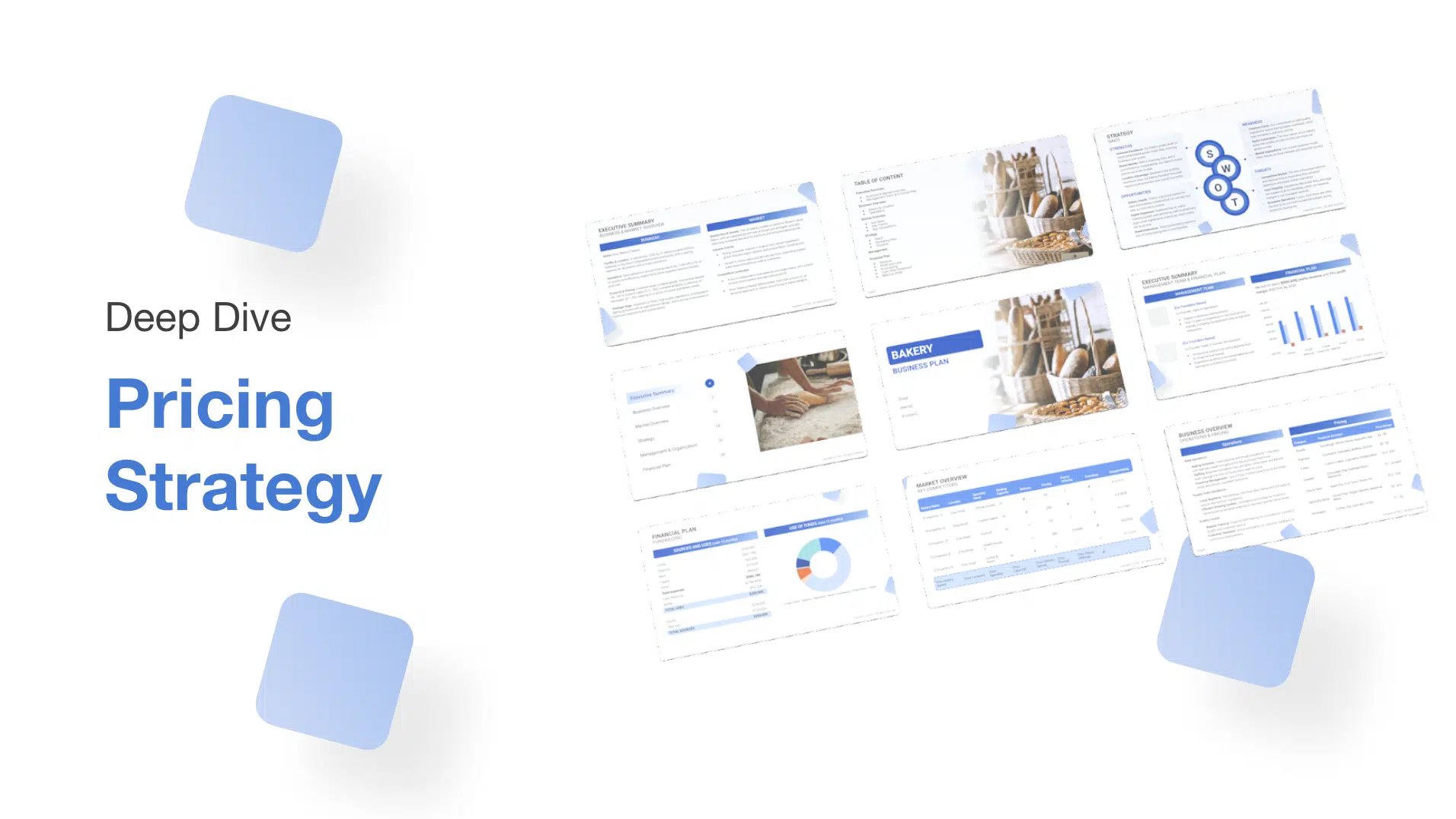
In this blog post, we’re diving into how to choose and explain your pricing strategy in your business plan. We’ll cover different pricing models like penetration, premium, and value-based. We’ll also dive into how to present your pricing strategy in your business plan.
Whether you’re starting a new business or preparing a business plan for an existing company, getting your pricing right is key to attracting customers and making a profit. Let’s break down how to make your pricing strategy clear and effective. Let’s dive in!
What are the different pricing strategies?
Different pricing strategies can significantly influence demand, profitability, and market positioning for businesses. Here’s an overview of some common pricing strategies:
- Cost-Plus Pricing: Adds a markup percentage to the cost of producing a product or delivering a service. It’s simple to calculate and ensures a profit margin.
- Value-Based Pricing: Sets prices based on the perceived value to the customer rather than the cost of production. This strategy focuses on the benefits and value the product or service brings to the customer.
- Competitive Pricing: Prices are set based on competitors’ pricing structures. Businesses might price their products slightly lower than competitors to gain market share or at a similar level to match the market rate.
- Penetration Pricing: Involves setting lower prices to enter a competitive market and attract customers quickly. The goal is to gain market share and then gradually increase prices.
- Premium Pricing: Setting the price of a product or service higher than the competitors. This strategy is used to signal superior quality or exclusivity to justify the higher cost.
- Dynamic Pricing: Adjusting prices in real-time based on market demand, competition, and other factors. Common in industries like hospitality and airlines.
- Freemium Pricing: Offering a basic product or service for free while charging for premium features. This strategy is often used by software and service companies to attract users.
- Bundle Pricing: Combining several products or services and selling them at a single price, often lower than the total cost of buying each item separately. This can increase the perceived value and encourage sales.
How to choose a pricing strategy
Here’s how to come up with an efficient pricing strategy:
Align Pricing with Market Strategy
Begin by articulating how your pricing strategy complements your overall market strategy. If you’re aiming for market penetration, explain how your pricing is designed to attract a large volume of customers by being more affordable than competitors.
For a premium pricing strategy, discuss the exceptional quality, exclusivity, or unique value your offerings bring, justifying higher price points.
If you’re adopting a value-based pricing model instead, illustrate how your pricing directly correlates with the perceived value to the customer, possibly through superior benefits or cost savings they provide.
Relate Pricing to the Target Market
Your pricing strategy should be closely tied to your understanding of your target market .
For instance, if your target market highly values sustainability and is willing to pay more for eco-friendly products, your pricing should reflect this. Similarly, if you’re targeting a price-sensitive segment, explain how your pricing strategy enables you to offer competitive value while maintaining profitability.
Consider the Competitive Landscape
A comprehensive pricing strategy also considers the competitive landscape . Analyze your competitors’ pricing and how your strategy positions you within this context.
Are you offering a more affordable alternative to premium products, or are you introducing a higher-quality option in a market segment dominated by low-cost competitors?
Discuss how your pricing strategy gives you a competitive edge, whether it’s by filling a gap in the market, offering better value, or challenging the status quo with innovative pricing models.
Where to include your prices in your business plan?
In your business plan, prices should be detailed under “Products or Services” within the Business Overview section of your business.
This part of the plan not only describes what you are offering but also provides an ideal opportunity to outline your pricing strategy and the specific prices or price ranges of your products or services.
Here, you can explain how your pricing fits into the market and aligns with your overall business strategy, giving potential investors or lenders a clear understanding of your approach to generating revenue.
Remember your pricing strategy should align with your financial projections (projected income statement, cash flow statement, and balance sheet). Indeed, you will need to give some high-level explanation of how you came up with these financial projections, based on your pricing strategy too.
Related Posts

Sit Still Franchise FDD, Profits, Costs & Fees (2025)
- December 4, 2024

Tapville Social Franchise FDD, Profits & Costs (2025)

Crisp & Green Franchise FDD, Profits & Costs (2025)
Privacy overview.

IMAGES
COMMENTS
Why is a pricing strategy important for a business plan? A business plan is a written document outlining a company’s core business practices – from products and services offered to marketing, financial planning and budget, but also pricing strategy. This business plan can be very lengthy, outlining every aspect of the business in detail.
May 16, 2024 · However, there is so much more to a business plan than just pricing. If you want help creating a business plan from scratch, consider Upmetrics. It offers a collection of 400+ sample business plans for ideas and inspiration. Furthermore, AI assistance and automated financials make the process even easier for new users. Interested? Try Upmetrics ...
Sep 4, 2024 · Importance of pricing strategy in a business plan. People often believe pricing strategy is mostly about selling a product or a service at the right price. Well, it’s more than that. Here are some of its noteworthy benefits: Clarity about financials. You get a clear view of all financial aspects including income, expenditure, and profit.
Jan 18, 2024 · The distinction between a pricing strategy and a pricing model lies in their scope, purpose, and application. The pricing strategy aligns prices with business objectives, market conditions, and customer perceptions. A pricing strategy considers market entry tactics, customer psychology, brand positioning, and long-term market objectives.
Why Your Pricing Strategy is Critical to Your Business Plan Financials. Your business plan’s financial projections are the roadmap for your business’s financial future. They outline your revenue expectations, expenses, and profitability.
Sep 4, 2024 · In your business plan, prices should be detailed under “Products or Services” within the Business Overview section of your business. This part of the plan not only describes what you are offering but also provides an ideal opportunity to outline your pricing strategy and the specific prices or price ranges of your products or services.